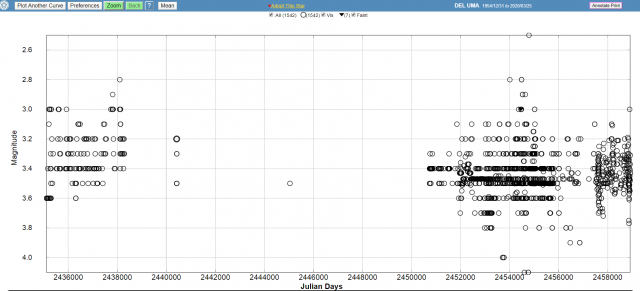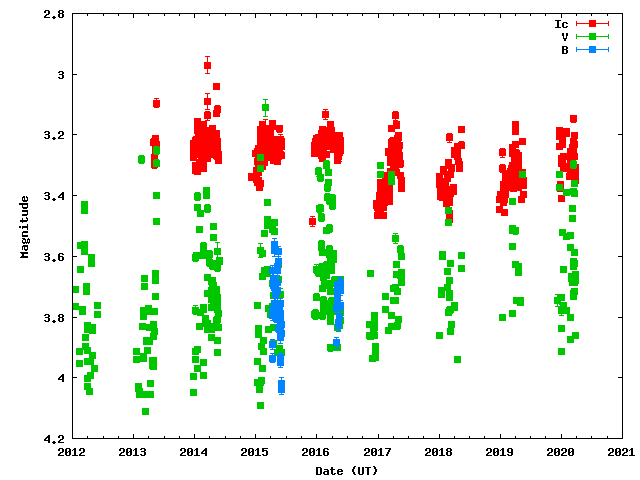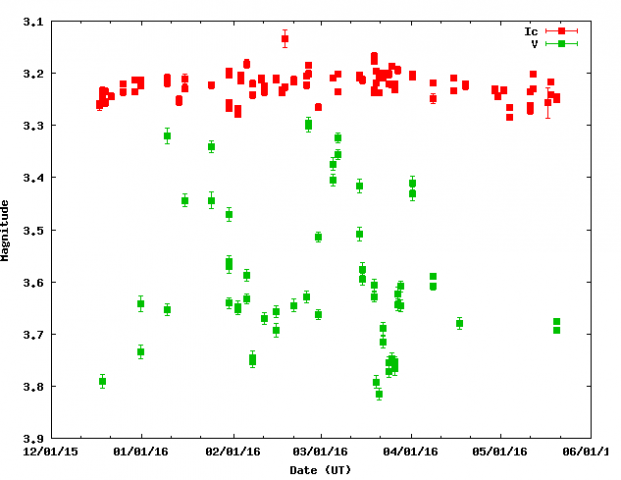› Forums › General Discussion › Whatever happened to Megrez?
- This topic has 33 replies, 9 voices, and was last updated 5 years, 8 months ago by
 Tracie Heywood.
Tracie Heywood.
-
AuthorPosts
-
26 March 2020 at 10:17 pm #574558
 Alan ThomasParticipant
Alan ThomasParticipantI went into the garden tonight at 21.55 to scan the sky.
I was startled to find that Megrez in Ursa Major (Delta Ursae Majoris), high in the sky, had disappeared! Was there something wrong with me? Or was there a temporary obscuration? Or what? Help!
27 March 2020 at 1:56 am #582149 Peter AndersonParticipant
Peter AndersonParticipantThis post piqued my interest so I did a little research:
My Research From ‘Wikipedia’ : This star has an excess emission of infrared radiation, indicating the presence of circumstellar matter. This forms a debris disk around an orbital radius of 16 Astronomical Units from the star. This radius is unusually small for the estimated age of the disk, which may be explained by drag from the Poynting–Robertson effect causing the dust to spiral inward.
From another internet site:
William Creed
Thursday, 2nd March 2017 5:58:14 AM
When I was a kid in around 1955 to 1969 that star was very visible in the night. Why has it seemed to fade over the 20 some years.
And another site:
Is it just me or is the star that connects the dipper with the handle fading out
There are no clouds its a cold , clear night
For those that can , step outside and observe
I have never come across this beforeIts barely there if at all(Feb 2013)
Finally Patrick Moore, in his book ‘Stargazing’ in 2001, at page 25 states:
“Old astronomers of more than 1,000 years ago stated that it was as bright as the other Ursa Major stars. Either they were wrong or (less probably) Megrez has actually faded about a magnitude since then.”
My question – Is it another case of dust obscuration – now becoming more rapid ???? Trouble is, at 57 degrees north it is just about inaccessible from here in Brisbane Australia…
27 March 2020 at 9:31 am #582151 Peter AndersonParticipant
Peter AndersonParticipantSeems I was getting excited over nothing. A colleague of mine emailed me some AAVSO information including the attached graph. Maybe in poorer sky conditions with the star near the limit of visibility,it appears to be fainter… I just don’t know.
 27 March 2020 at 9:40 am #582152
27 March 2020 at 9:40 am #582152 Peter AndersonParticipant
Peter AndersonParticipantThe diagram above starts at 31st December 1954 and ends at 25th March 2020. (Bit difficult to read). It shows little apparent variation in magnitude.
27 March 2020 at 9:55 am #582153 Nick WhiteParticipant
Nick WhiteParticipantI looked at it two or three nights ago while searching for the comet and thought to myself “That’s dimmer than I remember” and then carried on without a second thought. There doesn’t appear to be any AAVSO data for two or three nights ago.
 27 March 2020 at 10:52 am #582154
27 March 2020 at 10:52 am #582154 Alan ThomasParticipant
Alan ThomasParticipantThanks for those comments. So far I am reassured that I am not going nuts!
Alan
27 March 2020 at 12:32 pm #582155 Robin LeadbeaterParticipant
Robin LeadbeaterParticipantI was taking spectra last night and the signal from the target suddenly disappeared. I went outside to check and as far as I could tell the sky was completely clear. I went back inside and watched as the signal came back up. Half an hour later the same thing happened but this time I looked outside to find it was foggy, putting an end to observations
27 March 2020 at 6:27 pm #582156 Alan ThomasParticipant
Alan ThomasParticipantI had been out observing for a couple of hours earlier in the evening and was just having a final look around. So far as I can tell, the skies were perfectly clear. But I suppose a passing puff of cloud might be responsible. Or some other obstruction of course.
What surprised me was that Megrez was not simply faint but invisible, at least to the naked eye. That’s something I have never seen (or not seen) before in over 60 years of skywatching.
I will be having a closer look tonight with optical aid.
27 March 2020 at 10:19 pm #582157 Alan ThomasParticipant
Alan ThomasParticipantI went out at 20.30 and again at 21.50. I could detect Megrez with the naked eye, but only just, a little more easily with averted vision. It certainly seems unusually faint – but is it?
28 March 2020 at 10:45 am #582159 Gary PoynerParticipant
Gary PoynerParticipantThis is from KWS (Kamogata/Kiso/Kyoto Wide-field Survey). delta UMa also has a NSV designation (NSV 5513)
Gary
 28 March 2020 at 12:22 pm #582160
28 March 2020 at 12:22 pm #582160 Alan ThomasParticipant
Alan ThomasParticipantHi Gary
I am not a variable star observer. How would you interpret these data?
Thanks
Alan
28 March 2020 at 2:15 pm #582161 Gary PoynerParticipant
Gary PoynerParticipantHi Alan,
Well this is the first time I’ve seen a plot of delta UMa myself. VSX says the variability is of unspecified type, but this link suggests a possible EB http://liber.onu.edu.ua/pdf/astro/all/OAP_9/000_pdf/bryukh.pdf
It’s quite interesting that the amplitude of the fades vary from one fade to the next. Be nice to see a much longer plot. My eyes are possibly seeing a secondary wave on that light curve.
Gary
28 March 2020 at 3:00 pm #582162 Robin LeadbeaterParticipant
Robin LeadbeaterParticipantInteresting that the variability in I is much less than in V. Reminiscent of the recent Betelgeuse fading
28 March 2020 at 3:15 pm #582163 Robin LeadbeaterParticipant
Robin LeadbeaterParticipantIs the short term variation in KWS V mag real ? eg
 28 March 2020 at 3:28 pm #582164
28 March 2020 at 3:28 pm #582164 Alan ThomasParticipant
Alan ThomasParticipantI don’t know what the Ic V and B designations for the plots refer to, but do I detect a downward trend in the red plot – and an upward in the green? (this refers to Gary’s earlier post)
28 March 2020 at 4:14 pm #582166 Andy WilsonKeymaster
Andy WilsonKeymasterAccording to SIMBAD it is of A2Vn C spectral type. I also found reference to a debris disk in Wikipedia linking to a paper by Wyatt et al 2007 https://arxiv.org/pdf/astro-ph/0703608.pdf.
So it is a main sequence A-type star and the paper quotes an age of 300 Myr, though I think that comes from another paper (I’ve not read the paper in detail, just skimmed a few bits). I am surprised a main sequence star could have a debris disk as I thought this was associated with young stars. If I’ve understood the paper there are collisions in the debris disk generating dust and an IR excess. Perhaps the variation in luminosity is due to variable obscuration by the dust?
Interesting how such a well known and prominent star can throw up surprises to us, well spotted Alan!
28 March 2020 at 4:19 pm #582167 Robin LeadbeaterParticipant
Robin LeadbeaterParticipantB,V Ic correspond to the band in which the brightness was measured. (The survey instrument uses a CCD camera and wide field lens). V corresponds roughly to what the eye sees Ic is the near infrared. There are small long term average trends from season to season but the variation from day to day/week to week of up to 0.5 magnitudes seen in the V data would be obvious by eye if real. The very tight error bars on the points would suggest they are real but I am somewhat sceptical.
28 March 2020 at 4:28 pm #582168 Alan ThomasParticipant
Alan ThomasParticipantMany thanks, Robin, for the clarification on the data series. I never thought variable stars were that interesting – but I’m beginning to wonder now!
28 March 2020 at 6:00 pm #582169 Jeremy ShearsParticipant
Jeremy ShearsParticipantI too am sceptical about those V-band variations in the KWS, Robin. In spite of the tight errors bars.
The interesting thing is there whilst there are many photometric surveys of faints stars, there are very few surveys of bright stars like Megrez.
I think we should all take a leaf out of Alan’s book (me included!) and look up at the sky with our naked eyes to check if there is something out of the ordinary. After all, it was only a few weeks ago that Betelgeuse was observed to be dimming.
28 March 2020 at 6:54 pm #582170 Alan ThomasParticipant
Alan ThomasParticipantThanks Andy!
-
AuthorPosts
- You must be logged in to reply to this topic.
